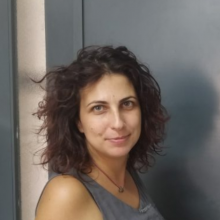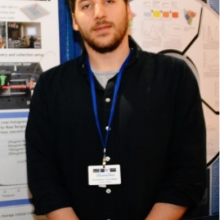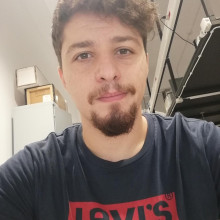
Dr. Dimitra Milioni received her Diploma on Applied Physics from the National Technical University of
Athens (NTUA), Greece and then pursued her studies (M.Sc.) on Molecular and Cellular Biophysics in
Pierre et Marie Curie University – Paris VI, France. She obtained her PhD degree on Biophysics from the
same University (2012). On 2013 she joined the Biosensors group at the Institute of Molecular Biology
and Biotechnology (IMBB-FORTH) until 2020, when she became a member of the Ultrafast Laser Micro-
and Nano- Processing Laboratory.
Her scientific interests lie on biosensors and their use for diagnostic purposes, as well as on the development of new methodologies for biosensor devices. Also, she is interested on model membranes (liposomes, supported lipid bilayers, BLM) and their interaction with other molecules (antimicrobial peptides, membrane proteins & amphiphilic polymers) for drug delivery applications.
Education
- PhD in Life Sciences (November 2012): “Photocontrolled Permeabilization of Biological Membranes; Studies on model membranes and cells”, BioMolecules Lab, Pierre et Marie Curie University, Chemistry dpt (UMR 7203, UPMC-CNRS-ENS), France.
- MSc.: “Molecular and Cellular Biophysics” (June 2009): Physics Faculty, Pierre et Marie Curie University (UPMC-Paris VI), France.
- 5-year Diploma: “Applied Physical Sciences” (July 2008): School of Applied Mathematical and Physical Sciences, National Technical University of Athens (NTUA), Greece.
Career
- Research Associate (September 2020 – today): Ultrafast Laser Micro and Nano Processing Laboratory, Institute of Electronic Structure and Lasers - Foundation for Research and Technology – Hellas (IESL – FORTH), Greece.
- Research Scientist (April 2013 – June 2020): Biosensors Lab, Institute of Molecular Biology and Biotechnology - Foundation for Research and Technology - Hellas (IMBB - FORTH), Greece.
- Postdoctoral Collaborating Researcher (October – December 2016): BioMolecules Lab, “Analysis, Molecular and Cellular Interactions” group, Pierre et Marie Curie University - National Center for Scientific Research - École Normale Supérieure (UMR 7203, UPMC
- Visiting Researcher (December 2012 – March 2013): Molecular Modeling and Drug Design Laboratory (Cournia Lab), Biomedical Research Foundation - Academy of Athens (BRFAA), Athens, Greece.
- Research Engineer (September – November 2012): BioMolecules Lab, “Analysis, Molecular and Cellular Interactions” group, Pierre et Marie Curie University - National Center for Scientific Research - École Normale Supérieure (UMR 7203, UPMC-CNRS-ENS), France
- Teaching Assistant (September 2009 – November 2012): 1st and 2nd semester courses (L1-PCME, LP111), Physics Faculty, Pierre et Marie Curie University (UPMC – Paris VI), France.
Interests
- Biosensors, new methodologies for biosensor devices
- Molecular biophysics
- Nanocarriers, nanoparticles & biological use
- Model membrane systems (liposomes, BLM, SLB)
- Cell membrane permeabilization & intermolecular interactions
- DNA and protein conformational changes & interactions
- Protein adsorption on surfaces, surface chemistry
Awards/Prizes/Distinctions
- 2015 - 2017: Postdoc Fellowship of Excellence by the State Scholarships foundation, Greece (ΙΚΥ-Siemens).
- 2016: French Ministry of National Education, Higher Education and Research. Grant for young researchers («Séjours scientifiques de haut niveau» - SSHN 2016).
- 2013: Qualified for Assistant Professor Positions in Higher Education in France (Section 28: Dense Mediums and Materials).
- 2009: French Ministry of National Education, Higher Education and Research. Research grant for PhD Thesis preparation.
- 2008: Regional Council of Île-de-France. Grant for Master Thesis preparation.

Konstantinos Tsimvrakidis received the Ph.D. in electronics and nanoscale engineering from University of Glasgow, U.K., and an M.Sc. in Nanoscience from University of Strathclyde, U.K. He is currently a Post-Doctoral Researcher with the Ultrafast Laser Micro and Nano Processing Laboratory Group at IESL-FORTH, Crete, Greece, running under the supervision of the director of research Dr. E. Stratakis. His research interests include optics, photonics, optoelectronics, laser spectroscopy, laser material processing.
Education
- 5/2020, Ph.D., “Singlet oxygen luminescence detection” – Department of Electronics and Nanoscale Engineering, University of Glasgow, Glasgow, UK.
- 9/2019, M.Sc. in Nanoscience – Department of Physics & Chemistry, Strathclyde University, Glasgow, UK.
- 7/2014, B.Sc. in Electrical and Electronics Engineering – Technological Educational Institute of Central Greece.
Career
- 12/2020 – Today, Post-doctoral Researcher, Ultrafast Laser Micro and Nano Processing (ULMNP) group, Institute of Electronic Structure and Laser (IESL), Foundation for Research and Technology-Hellas (FORTH), Heraklion, Crete, Greece.
Interests
- Laser material synthesis
- Optics and photonics
- Laser Spectroscopy
- Time-correlated single photon counting techniques
- Single photon detection

Mr. Christos Ntoulias is the Laboratory Manager and Lead Mechanical Engineer at the Ultrafast Laser Micro- and Nano-processing Laboratory (ULMNP) within the Institute of Electronic Structure and Laser (IESL). He holds a Master of Engineering (MEng) from the University of Patras (2019) and has been a key member of the ULMNP team since September 2020. In his current role, Christos leads the design and development of 2D/3D models for custom experimental setups, and oversees the operation and maintenance of the laboratory’s core facilities, including 3D printing, laser systems, and automated equipment.
Education
- 10/2013 -4/2019 Master of Engineering in Mechanical Engineering and Aeronautics department in University of Patras
Career
- 9/2020 – Today Lead Mechanical Design Engineer/Laboratory Manager for Ultrafast Laser Micro-and-Nano-processing Group
- 10/2018-4/2019 – Diploma thesis “SYNTHESIS, CHARACTERIZATION AND MECHANICAL BEHAVIOR OF A 3D-PRINTED BIO-SCAFFOLD” in the Laboratory of Applied Mechanics and Materials Engineering at the University of Patras.
- 7/2017-9/2017 – Internship as Junior Mechanical Engineer in Adamant Composites Ltd
Interests
- CAD/CAM technologies
- Automations for Laser and 3D-printing Experiments
- FEM Analysis
- 3D Printing
- Bioprinting
- Sustainability(LCA)

Education
- 2018, BSc, Department of Chemistry, University of Crete, Greece
- 2020, MSc, Department of Chemistry, University of Crete, Greece
Career
- 2/2021-today, Ph.D. candidate, Department of Chemistry, University of Crete, Greece
Interests
- Self-healing polymers and composites
- Organic-inorganic nanohybrid materials
- Polymer crystallization
- Polymer surfaces and interfaces
- Analytical Chemistry
- Electrochemistry
- Biosensor construction and development
Position Description
Characterisation of Chemical Compounds and evaluation of their environmental effects.
For the full announcement, follow the link "Related Documents"
Related Project
InComEss -Required Qualifications
- Degree in Engineering Sciences
- Experimental experience in characterisation of Chemical Compounds
- Experience in the evaluation of environmental effects of Chemical Compounds
- Good knowledge of English
Application Procedure
Interested candidates who meet the aforementioned requirements are kindly asked to submit their applications to the address (hr@iesl.forth.gr), with cc to the Scientific Responsible, Dr Emmanuel Stratakis (stratak@iesl.forth.gr).
In order to be considered, the application must include:
- Application Form (form Greek or form English to the left)
- Detailed curriculum vitae (CV) of the candidate
- Scanned Copies of academic titles
- Certificate for enrollment in a master’s program
Appointment Duration
6 monthsFunding

To: 19/05/2021 14:00
One of the most important scientific and technological frontiers of our time is the interfacing of electronics with the human brain. This endeavour promises to help understand how the brain works and deliver new tools for diagnosis and treatment of pathologies including epilepsy and Parkinson’s disease. Current solutions, however, are limited by the materials that are brought in contact with the tissue and transduce signals across the biotic/abiotic interface. Recent advances in electronics have made available materials with a unique combination of attractive properties, including mechanical flexibility, mixed ionic/electronic conduction, enhanced biocompatibility, and capability for drug delivery. I will present examples of novel devices for recording and stimulation of neurons and show that organic electronic materials offer tremendous opportunities to study the brain and treat its pathologies.


